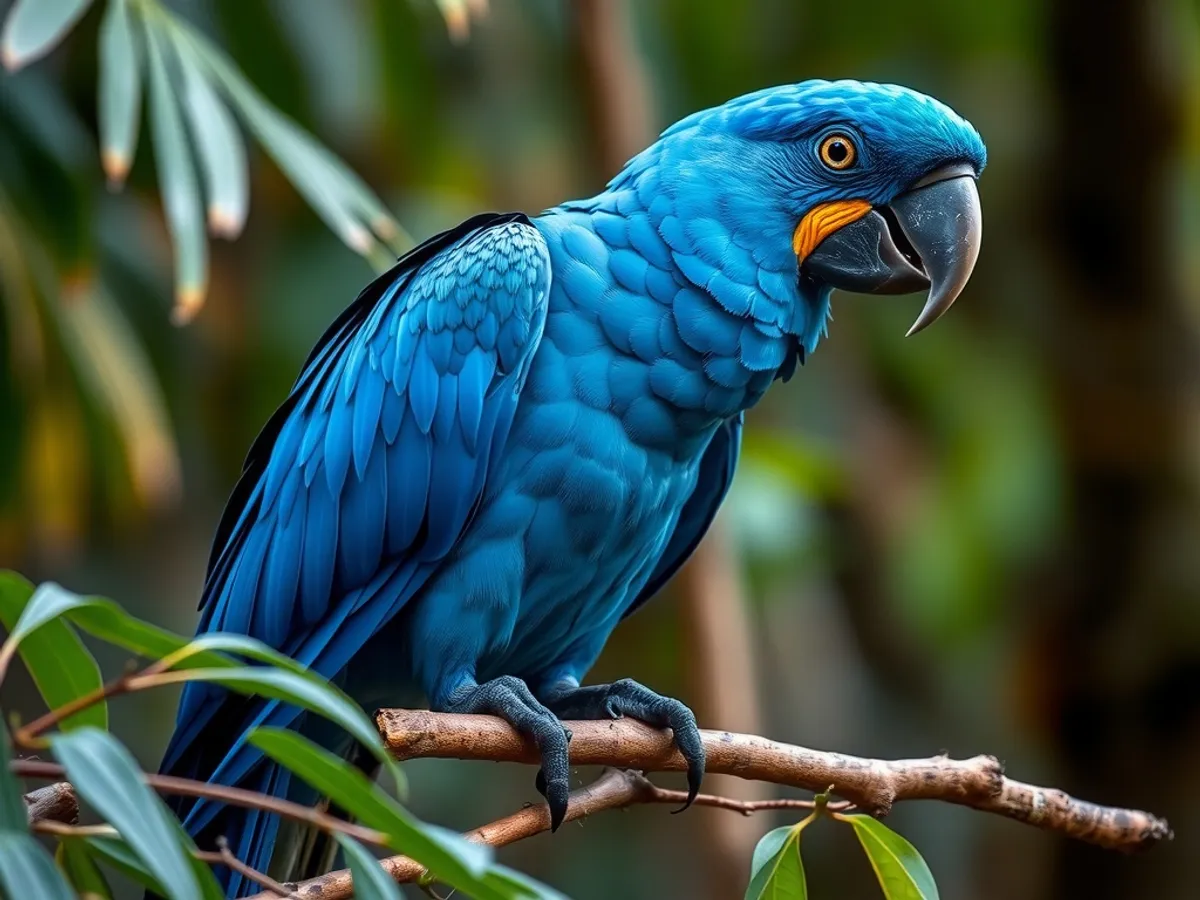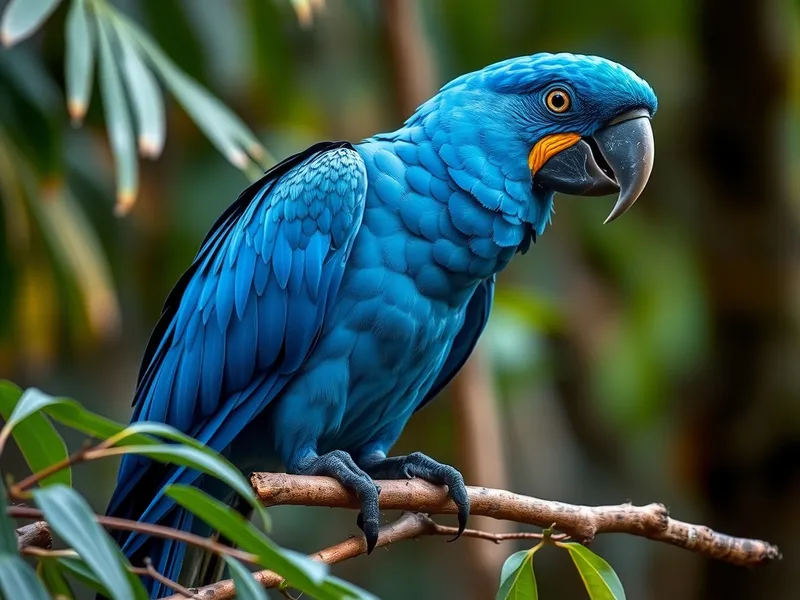
Hyacinth Macaw
Anodorhynchus hyacinthinus

Meet the Hyacinth Macaw
The Hyacinth Macaw is the largest flying parrot species in the world, known for its striking cobalt-blue plumage and powerful, curved black beak. Native to central and eastern South America, especially Brazil, these birds inhabit palm swamps, woodlands, and open grasslands. They feed primarily on nuts from native palms, using their strong beaks to crack open even the toughest shells. Highly social and intelligent, Hyacinth Macaws form strong bonds and communicate with a variety of vocalizations. Due to habitat loss and illegal pet trade, their populations have declined, making them a vulnerable species.
Classification
Bird
Habitat
Tropical and subtropical forests, palm swamps, and open woodlands
Diet
Herbivore
Lifespan
35-50 years in the wild, up to 60 years in captivity
Conservation
Vulnerable
Weight
1.2–1.7 kg (2.6–3.7 lbs)
📖Fascinating Facts
Largest Flying Parrot
The Hyacinth Macaw is the largest flying parrot species, reaching up to 1 meter (3.3 feet) in length from beak to tail.
Palm Nut Specialist
Its diet is highly specialized, relying on nuts from native palm trees, especially the acuri and bocaiuva palms.
Loud Communicators
These macaws are known for their loud calls, which can be heard over long distances in their natural habitat.
📋Detailed Description
The Hyacinth Macaw (Anodorhynchus hyacinthinus) is the world’s largest flying parrot, measuring up to 100 cm (39 inches) in length and weighing between 1.2 and 1.7 kg (2.6–3.7 lbs). Its striking cobalt-blue plumage is complemented by bare yellow skin around the eyes and at the base of the lower mandible, a feature unique among macaws. The massive, curved beak is black and exceptionally strong, capable of exerting forces sufficient to crack the hard nuts of native palm species, such as Attalea and Syagrus. Hyacinth Macaws possess zygodactyl feet (two toes facing forward, two backward), enhancing their climbing and manipulation abilities. These parrots are highly social, often seen in pairs or small family groups, and occasionally in larger flocks, especially outside the breeding season. Their vocalizations are loud and guttural, serving both social and territorial functions. In the wild, they are known for their intelligence, problem-solving abilities, and complex social interactions. Hyacinth Macaws are long-lived, with lifespans exceeding 30 years in the wild and up to 50 years in captivity. Their range spans the Pantanal, Cerrado, and parts of the Amazon basin, with populations fragmented due to habitat loss. They are cavity nesters, preferring large, mature trees or palm stumps for breeding sites, which are increasingly scarce.
💡 Did you know?
Despite their size and strength, Hyacinth Macaws are gentle giants and often use their feet like hands to manipulate objects and food.
🔬Research & Sources
Wikipedia Summary
The hyacinth macaw, or hyacinthine macaw, is a parrot native to central and eastern South America. With a length of about one meter it is longer than any other species of parrot. It is the largest macaw and the largest flying parrot species. While generally easily recognized, it could be confused with the smaller Lear's macaw. Habitat loss and the trapping of wild birds for the pet trade have taken a heavy toll on their population in the wild, so the species is classified as Vulnerable on the International Union for Conservation of Nature's Red List, and it is protected by its listing on Appendix I of the Convention on International Trade in Endangered Species of Wild Fauna and Flora (CITES).
Last Modified: 6/10/2025
🎭Behavior & Social Structure
Hyacinth Macaws are diurnal and spend much of their day foraging, socializing, and preening. They are primarily frugivorous, specializing in the nuts of certain palm species, such as the acuri (Attalea phalerata) and bocaiuva (Acrocomia aculeata), which they access using their powerful beaks and dexterous tongues. Foraging often occurs in the early morning and late afternoon, with midday spent resting or engaging in social activities. These macaws exhibit strong pair bonds and mutual grooming (allopreening), which reinforces social cohesion. Outside the breeding season, they may form loose flocks of up to 30 individuals. They are known for their playfulness and curiosity, frequently manipulating objects and exploring their environment. Roosting typically occurs in tall trees, often communally. Their vocal repertoire includes loud squawks, screeches, and softer contact calls, used to maintain group cohesion and communicate alarm.
👶Reproduction & Life Cycle
Hyacinth Macaws are monogamous, forming lifelong pair bonds. The breeding season varies regionally but generally occurs from July to December. Courtship involves mutual preening, feeding, and synchronized vocalizations. Nests are typically constructed in natural cavities of large trees, especially manduvi (Sterculia apetala) in the Pantanal, or in palm stumps where trees are scarce. Clutch size is usually two eggs, but typically only one chick survives to fledging due to siblicide or resource limitation. Incubation lasts approximately 28–30 days, with the female incubating while the male provides food. Chicks are altricial, hatching blind and helpless, and remain in the nest for about 100–110 days. Both parents participate in feeding and protecting the chick. Juveniles remain dependent on parents for several months post-fledging, learning essential foraging and social skills.
🛡️Adaptations & Survival
The Hyacinth Macaw’s most notable adaptation is its exceptionally strong beak, which allows it to exploit hard-shelled palm nuts that are inaccessible to most other animals. Its zygodactyl feet and prehensile tongue facilitate precise manipulation of food and objects. The vivid blue plumage provides camouflage among the dappled light of the forest canopy. Their loud vocalizations are adapted for long-distance communication in dense habitats. Social intelligence, including cooperative foraging and complex social bonds, enhances survival in variable environments. Their ability to utilize a variety of nesting sites, including palm stumps and tree cavities, is a response to habitat alteration.
📚Research Sources
🎨Cultural Significance
The Hyacinth Macaw is an iconic symbol of the Brazilian Pantanal and Cerrado, often featured in ecotourism and conservation campaigns. Its striking appearance and rarity have made it a status symbol in the illegal pet trade. In indigenous folklore, macaws are sometimes associated with the sun and sky, symbolizing beauty and freedom. The species has inspired artwork, literature, and environmental awareness efforts, particularly in Brazil, where it is sometimes called 'Arara-azul'.
🔬Recent Research & Discoveries
Recent research has focused on the macaw’s ecological role as a seed disperser, its genetic diversity, and the effectiveness of artificial nest boxes in supporting breeding success. Studies have shown that Hyacinth Macaws are keystone species in the Pantanal, influencing palm regeneration. Conservation programs, such as Projeto Arara Azul, have successfully increased local populations through habitat protection and community engagement. Ongoing genetic studies are assessing population structure and inbreeding risks. Behavioral research has highlighted their advanced problem-solving skills and capacity for tool use in captivity.
🎥Wildlife Videos

Hyacinth Macaws Run a Unique Seed-Distribution Service | Wild to Know
The Pantanal in central South America is the world's largest tropical wetland, home to an astonishing variety of unique flora and ...
Terra Mater
![The Macaw Kingdom | Documentary [Expedition Edition]](https://i.ytimg.com/vi/3ieppWouPxk/hq720.jpg?sqp=-oaymwEnCOgCEMoBSFryq4qpAxkIARUAAIhCGAHYAQHiAQoIGBACGAY4AUAB&rs=AOn4CLCwZB_1ZAKu1MRoPcjcrRX3Hct6MQ)
The Macaw Kingdom | Documentary [Expedition Edition]
The Macaw Kingdom | Full Documentary (HD) Enter one of the last uncharted rainforests on Earth-the Candamo Basin-in this ...
Wildlife Messengers

The Big Blue Bird | Dr. K's Exotic Animal ER
#NatGeoWILD #BlueMacaws #DrK About Dr. K's Exotic Animal ER: Dr. Susan Kelleher owns and operates one of the busiest ...
Nat Geo Animals

Hyacinth Macaw | South America's Weirdest Animals | Nat Geo Wild
Hyacinth macaws are the largest parrots in the world. #hyacinthmacaw #macawbird #natgeowild.
Smoothie the Ankylosaurus

Hyacinth Macaw feeding behavior IN THE WILD!
Very interesting video of Hyacinth Macaws feeding on their favorite palm nut, the "Acuri" in Pantanal - Brazil. If you are new to ...
Calyptura Expeditions

Hyacinth Macaw Parrot Gets Smuggled Into Britain | Wildlife Patrol
Wildlife crime fighter Dr. Rhys Jones features in never seen before access to wildlife investigations including police raids, ...
Real Wild
🌍Habitat Information
The Hyacinth Macaw typically inhabits Tropical and subtropical forests, palm swamps, and open woodlands environments. Hyacinth Macaws have adapted to their environments with specialized features and behaviors.
Primary Habitat:
Tropical and subtropical forests, palm swamps, and open woodlands
More detailed habitat information will be available soon.
🛡️Conservation Status
The Hyacinth Macaw is currently classified as Vulnerable. Conservation efforts are crucial for preserving this species for future generations.
Common Threats:
- 🏠Habitat loss and fragmentation
- 🌡️Climate change impacts
- 🎯Hunting and poaching
- 🏭Human-wildlife conflict
⚠️Threats & Conservation Challenges
Major threats to the Hyacinth Macaw include habitat loss due to deforestation, conversion of land to agriculture and cattle ranching, and selective logging of nesting trees. Illegal trapping for the pet trade, particularly in the late 20th century, caused severe population declines. The species’ dependence on specific palm nuts and large nesting cavities makes it vulnerable to habitat fragmentation and resource depletion. Current population estimates suggest 6,500–7,000 individuals remain in the wild, with the largest subpopulation in the Pantanal. Conservation challenges include protecting nesting sites, restoring palm populations, and curbing illegal trade. Climate change and increased frequency of wildfires also pose emerging risks.
🔬Scientific Classification
Scientific Name
Anodorhynchus hyacinthinus
Classification Hierarchy
🔍 About Taxonomic Classification
Taxonomic classification is a hierarchical system used by scientists to classify and organize living organisms based on shared characteristics and evolutionary relationships.
The system moves from broad categories (Kingdom) to increasingly specific ones, with each animal's scientific name typically consisting of its Genus and species.
📝Community Notes
Share your observations and insights about the Hyacinth Macaw with our community of wildlife enthusiasts.
Join Our Community
Sign in to share your observations and connect with fellow wildlife enthusiasts.
Sign In to ContributeNo community notes yet
Be the first to share your observations about the Hyacinth Macaw!
Explore Hyacinth Macaw
Select a tab above to learn more about this amazing animal.
📸Photo Gallery
No photos available for this animal yet.
🌟Discover More Wildlife
Continue your journey of discovery with more fascinating animals from our database
